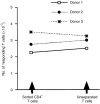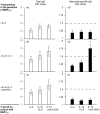Immune responses to Plasmodium falciparum-merozoite surface protein 1 (MSP1) antigen, II. Induction of parasite-specific immunoglobulin G in unsensitized human B cells after in vitro T-cell priming with MSP119
- PMID: 10447773
- PMCID: PMC2326866
- DOI: 10.1046/j.1365-2567.1999.00804.x
Immune responses to Plasmodium falciparum-merozoite surface protein 1 (MSP1) antigen, II. Induction of parasite-specific immunoglobulin G in unsensitized human B cells after in vitro T-cell priming with MSP119
Abstract
A baculovirus recombinant antigen corresponding to the C-terminal 19 000 MW fragment of Plasmodium falciparum merozoite surface protein 1 (MSP119), has been used to prime T cells from individuals with no previous exposure to malaria, to provide help for the induction of a parasite specific antibody response in vitro. Although MSP119 alone could induce a small but detectable T-cell response, which included interleukin-4 (IL-4) secretion, this response was significantly increased by the presence of IL-2. In addition, IL-4 was shown to synergize with IL-2 for the induction of antigen-specific T-cell responses. If interferon-gamma (IFN-gamma), IL-12, or neutralizing anti-IL-4 antibody was present at the time of priming, the T-cell responses were abolished. Parasite-specific immunoglobulin G (IgG) could be detected after secondary restimulation with MSP119, IL-10 and anti-CD40 monoclonal antibody in cultures containing MSP119 primed T cells, autologous B cells, IL-2 and IL-4. No antibody was secreted in the absence of primed T cells in this B-cell culture assay. These data show that recombinant MSP119, a leading malaria vaccine candidate, can prime non-immune human lymphocytes under defined in vitro experimental conditions, which include regulatory cytokines and/or other costimulatory molecules. This is a complementary approach for exploring immunogenic mechanisms of potential vaccine candidates such as P. falciparum antigens in humans.
Figures





Similar articles
-
Secretion of parasite-specific immunoglobulin G by purified blood B lymphocytes from immune individuals after in vitro stimulation with recombinant Plasmodium falciparum merozoite surface protein-119 antigen.Immunology. 1999 Jun;97(2):204-10. doi: 10.1046/j.1365-2567.1999.00763.x. Immunology. 1999. PMID: 10447733 Free PMC article.
-
Human immune response in Plasmodium falciparum malaria. Synthetic peptides corresponding to known epitopes of the Pf155/RESA antigen induce production of parasite-specific antibodies in vitro.J Immunol. 1991 Oct 1;147(7):2295-301. J Immunol. 1991. PMID: 1717554
-
Immunogenicity of a chimeric Plasmodium falciparum merozoite surface protein vaccine in Aotus monkeys.Malar J. 2016 Mar 15;15:159. doi: 10.1186/s12936-016-1226-5. Malar J. 2016. PMID: 26975721 Free PMC article.
-
Manipulating blood T cells and B cells from squirrel monkeys: some technical considerations.J Immunol Methods. 1994 Aug 1;173(2):165-73. doi: 10.1016/0022-1759(94)90296-8. J Immunol Methods. 1994. PMID: 8046251 Review.
-
Non-parasite-specific cytokine responses may influence disease outcome following infection.Immunol Rev. 1992 Jun;127:51-68. doi: 10.1111/j.1600-065x.1992.tb01408.x. Immunol Rev. 1992. PMID: 1506007 Review. No abstract available.
Cited by
-
Plasmodium vivax promiscuous T-helper epitopes defined and evaluated as linear peptide chimera immunogens.Infect Immun. 2002 Jul;70(7):3479-92. doi: 10.1128/IAI.70.7.3479-3492.2002. Infect Immun. 2002. PMID: 12065487 Free PMC article.
-
Age-related differences in naturally acquired T cell memory to Plasmodium falciparum merozoite surface protein 1.PLoS One. 2011;6(9):e24852. doi: 10.1371/journal.pone.0024852. Epub 2011 Sep 16. PLoS One. 2011. PMID: 21935482 Free PMC article.
-
Regulation of antigen-specific immunoglobulin G subclasses in response to conserved and polymorphic Plasmodium falciparum antigens in an in vitro model.Infect Immun. 2002 Jun;70(6):2820-7. doi: 10.1128/IAI.70.6.2820-2827.2002. Infect Immun. 2002. PMID: 12010968 Free PMC article.
-
Genetic determinants of anti-malarial acquired immunity in a large multi-centre study.Malar J. 2015 Aug 28;14:333. doi: 10.1186/s12936-015-0833-x. Malar J. 2015. PMID: 26314886 Free PMC article.
-
Antibodies to malaria vaccine candidates are associated with chloroquine or sulphadoxine/pyrimethamine treatment efficacy in children in an endemic area of Burkina Faso.Malar J. 2012 Mar 22;11:79. doi: 10.1186/1475-2875-11-79. Malar J. 2012. PMID: 22439695 Free PMC article.
References
-
- Engers HD, Godal T. Malaria vaccine development. Parasitol Today. 1998;14:56. - PubMed
-
- Good MF, Kaslow DC, Miller LH. Pathways and strategies for developing a malaria blood-stage vaccine. Annu Rev Immunol. 1998;16:57. - PubMed
-
- Perraut R, Garraud O. Essais vaccinaux et réponse immune contre Plasmodium falciparum chez le singe. Saimiri Méd Trop. 1998;58:76. - PubMed
-
- Holder AA, Riley EM. Human immune response to MSP-1. Parasitol Today. 1996;12:173. - PubMed
-
- Egan AF, Morris J, Barnish G, et al. Clinical immunity to Plasmodium falciparum malaria is associated with serum antibodies to three 19-kDa C-terminal fragment of the merozoite surface antigen, PfMSP-1. J Infect Dis. 1996;173:765. - PubMed
MeSH terms
Substances
LinkOut - more resources
Full Text Sources
Other Literature Sources
Research Materials

